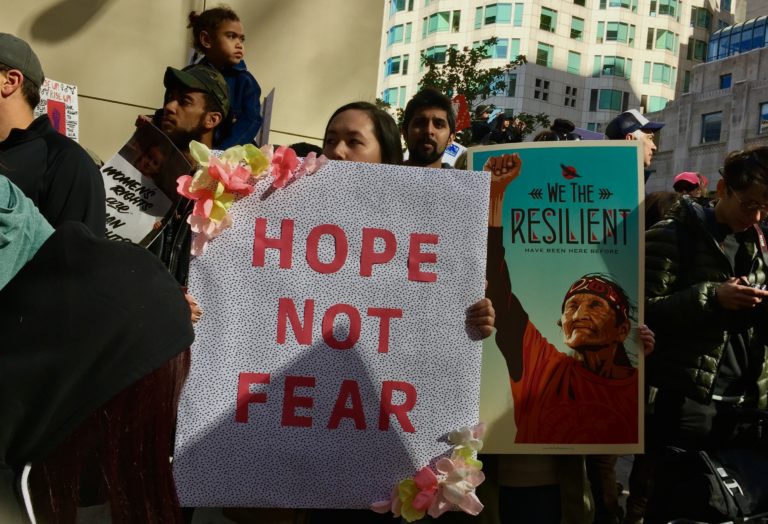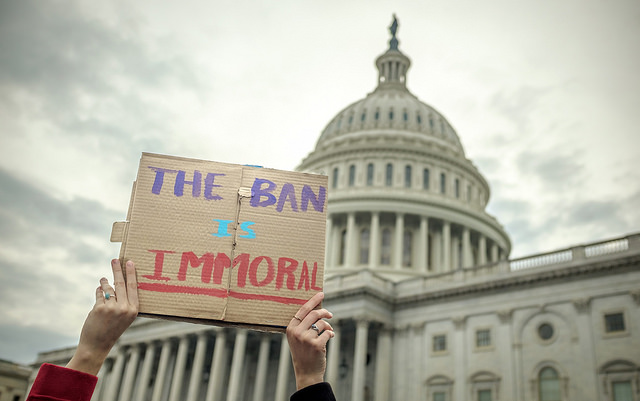Gwyneth Shanks discusses the scope of Not a Trump Issue, which privileges resistant actions that are never reducible to nor fully concerned with the Trump Administration’s policies and actions. In the wake of the Administration’s tacit and overt support of white supremacist and sexist ideologies, deregulation, global climate change denial, and attempts at voter suppression and the criminalization of communities of color, “Not a Trump Issue” questions how radical, anti-racist, feminist scholars, artists, activists, and educators can enunciate their own forms of resistance. The issue privileges actions that are engaged with surfacing deeper historical structures of inequity or dispossession; the issues at stake for the authors in “Not a Trump Issue” is not not Trump nor our political present, but always already our collective pasts.
Issue 6.2 (Winter 2017) — Not a Trump Issue
Edited by Gwyneth Shanks
In the wake of the Trump administration’s tacit and overt support of white supremacist and sexist ideologies, deregulation, global climate change denial, and attempts at voter suppression and the criminalization of communities of color, “Not a Trump Issue” questions how radical, anti-racist, feminist scholars, artists, activists, and educators can enunciate their own forms of resistance. The issue privileges actions that are engaged with surfacing deeper historical structures of inequity or dispossession; the issues at stake for the authors in “Not a Trump Issue” is not not Trump nor our political present, but always already our collective pasts.
Language is a Public Thing
Manifestos have resurfaced as fuel for firing political imaginations and calling people to action in a threatening time. But what can they really accomplish? A rethinking of the limitations of manifestos—their panic-driven contexts, their emphasis on collectivities rather than individuals, the vagueness and combativeness of their language—suggests that there may be other more fruitful ways of instilling care of and for language in everyday life and politics. With due deference to Orwell for his focus on the political dangers of not caring for language, we posit that his prescriptions can also inhibit our abilities to communicate in productive ways, across disparate communities that might stand to gain from breaking out of strictures on political language and expression. Inspired by Arendt’s call to “think what we are doing,” we propose as a starting point a language charter that will make language everyone’s business.
The Politics and Policy of Noise: Motorcycles Making, Masking, and Muddling the Noise of Protest
Noise plays a specific role in the politics of protest. The use of motorcycles to display affiliations, to protest status quo, and to challenge dominant ideologies is powerful, purposeful, and politically messy. In this essay, I trace the use of motorcycles in various modes of protest; I focus on how motorcycles disrupt the social, revealing the indelible charge of sensorial codes of meaning of producing noise—the productive process of drowning out voices, the turning up the volume of dissident perspectives such as how the San Francisco Dykes on Bikes established a sonic audibility in the 1970s to the recent off-duty motorcycle policemen who through using the loudness of their motorcycles protested Death penalty opponents, to the Patriot Guard Riders who mask the bullhorns of the Westboro Baptist Church protests.
Sideways Fences: Resisting Gentrification in Boyle Heights, a Los Angeles Community
From the introduction of hipster IPA beer to fences that go sideways (instead of up and down), Oscar Arguello’s Sideways Fences (2017) explores the gentrification of Boyle Heights, a predominately Latino/a community near downtown Los Angeles. Sol, the main character, is pregnant and lives with her boyfriend Estéban, who drinks too much and spends his discretionary time fixing up a ’52 Chevy. Early in the play, Eva, Sol’s sister, crashes with the couple. The play centers around the trio’s stressed relationship and Sol and Estéban’s upcoming eviction, which is related to the creation of new condos. While at first glance the play appears to embrace common stereotypes including the wayward Latina (Eva) and the alcohol prone Latino, a closer analysis illuminates Arguello’s artistic layering of stereotypes to make legible the conditions/structures that produce the situations in which the trio find themselves.
Persistence in Pedagogy: Teaching Failure, Empathy, and Citation
This self-reflexive essay addresses issues of teaching and pedagogy for social change in the Trump era. It places current teaching reflections in the context of the history of the corporatization of the university, systemic inequities in academia, and current political debates. It expands upon the structure of a teaching philosophy in order to share critical reflection, relevant sources, and pedagogical strategies drawn from the author’s experience teaching in dance departments.
Arab American Life in the Trump Era: An Interview with Moustafa Bayoumi
In this interview, award-winning author Moustafa Bayoumi, Professor of English at Brooklyn College, CUNY and board member of Lateral, discusses Arab American life, social justice, and the rhetoric of the War on Terror in the Trump era and beyond. He also shares his views on identity politics as well as strategies of connection, resilience, and resistance in times of struggle.
“Truth” in the Age of Trump
Cultural studies scholars have a long history of problematizing the concept of truth. Today, however, many on the left have turned to the tactic of calling out Trump’s lies, enumerating them, fact-checking them, and countering them with contrary evidence. While well-intentioned, dependence on calls for fact-checking and slogans that proclaim allegiance to science without acknowledging the cultural and social factors that affect knowledge production risks reifying some of the problems that early cultural studies scholars rightly highlighted. This essay argues, ultimately, that cultural studies scholars, activists, teachers, and critical theorists should resist the urge to set down the tools of critical theory but instead to apply them with abandon to Trump, his policies, and, perhaps most importantly, to ourselves.
Not About White Workers: The Perils of Popular Ethnographic Narrative in the Time of Trump
This essay rasies three concerns about popular contemporary ethnographies that focus on the rural and white “working class.” First, these ethnographies are not treated as partial accounts of cultural experience but are instead taken as straightforward political and economic analyses. Second, these ethnographies amplify an “empathy mandate,” which demands that our political actions center on trying to understand misunderstood populations—in this case, the so-called “white working class.” Third, by disarticulating the cultural markers of “working classness” from the material conditions of class, these ethnographies obscure the political significance of “working class.” Ethnographies of “white working class” experience may be useful only if we treat them as small openings that lead to bigger and broader stories, rather than as complete and transparent explanations of what is going on.
The Trump Wall: a Cultural Wall and a Cultural War
This essay decodes a Wall-DNA in American culture with an examination of two shaping moments in history, namely the Founding Fathers and the Mexican-American War. It argues that the Trump Wall, instead of protecting, endangers American values and opportunities; instead of uniting the nation, divides it and ignites cultural wars. The Trump Wall portends fear, bigotry, distrust, intolerance and disconnection; it is the Trump War. Therefore, this border construction is more of a mental construct than a physical one, especially when it involves a cultural re-landscaping and boundary shifting between the US and Mexico and within the two nations. The essay also challenges a one-dimensional and static view on American values, and calls for a 21st century sophistication for a culturally nuanced definition of what America means, and a 21st century agility to cross back and forth any walls without sparking a war.
Missives and Other Un-Notes
Beginning his series of disorienting and theatrical vignettes with an extended introduction, Gamboa describes his childhood and young adulthood coming of age in Los Angeles in the 1960s and 70s. It is through these stories of prejudice in elementary school and of mass action against police brutality and the national government’s neglect of communities of color, Gamboa implies, that readers should approach his text. Missives and other Un-notes skewers myths of US national identity, masculinity, and whiteness, placing readers in a dystopic world of violence, surveillance, and the constant threat of annihilation.
#eatthatwall
#eatthatwall is an in-progress performance-installation, presented first at Rhizome DC (a DIY experimental art space in Takoma Park, Washington, DC) on April 23, 2017. The project invited gallery participants to assist in the construction and eating of an edible wall made with approximately 1,200 mini cooked rice bricks set with refried bean mortar. The wall served as an imaginary, fabulist structure to separate a currently un-bordered area between Laredo in Texas and Nuevo Laredo in Tamaulipas, Mexico, or anywhere else this hypothetical border might arbitrarily fit. The performance score following the introduction to the project is a document of the process of making: from initial concepts, to the invitation to build/mimic, to a contemplation of how we digest the events and emotions leading to the wall, and to its eventual end.
Rage Grief Comfort &
Documentation and analysis by Laurie Beth Clark and Michael Peterson of a project by the arts collective Spatula&Barcode: In December 2016 a major city building in Madison, Wisconsin was closed for renovation, and enterprising curators installed a massive temporary art exhibition, titled Municipal. As the community was in the midst of processing the presidential election results, we created Rage Grief Comfort & with the explicit aim of moving participants through and past their immediate emotions.
No Pestilence at the Border
In this poem, I explore what various politicians have stated about immigrants using pest metaphors while interweaving pest control discourses. A pest is an animal that is “out of place.” Immigrants, too, are often “out of place” or “uprooted” or in between places. They live between the world in which they are from and the world in which they inhabit presently, never fully fitting into either world. As there is a multiplicity of immigrants who choose to cross the border from Mexico, there is also a multiplicity of pests who cross different kinds of borders and boundaries. Pests and immigrants are liminal beings, making some people uneasy. My intention here is not to universalize the figure of the immigrant nor the figure of the pest, but instead to explore the complications of immigration-pest discourse in US political cultures.












